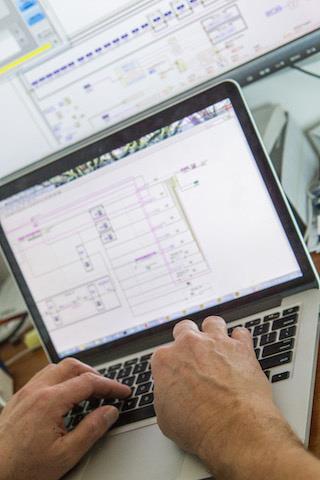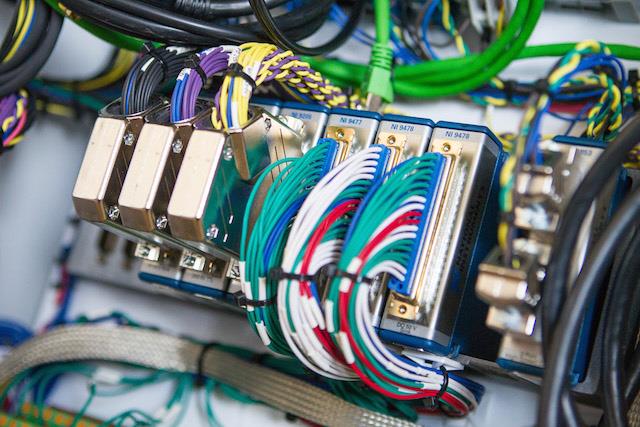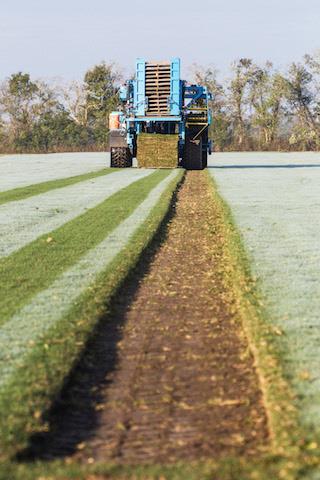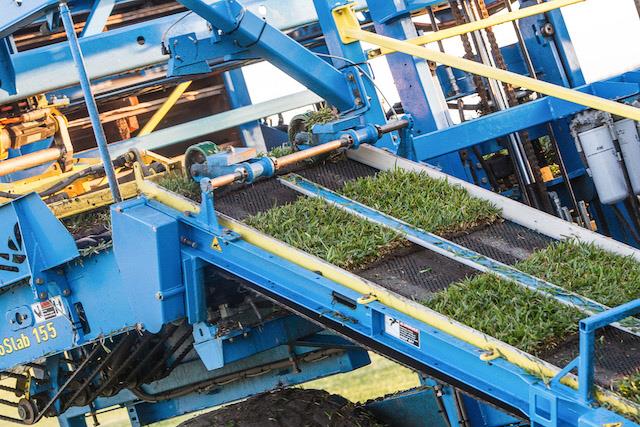The FireFly Approach
Recognising these shortcomings, FireFly worked to build a smarter machine that manages and synchronises multiple parallel processes to automate cutting and stacking turf grass. First, a cutter lifts the turf from the ground and cuts it into slabs that conveyors transport to the rear of the machine. A stacker attached to a gantry then moves the cut slabs from the conveyors to the pallet. As each turf slab is stacked onto the pallet, a set of pallet forks lowers the pallet of turf closer to the ground. Once stacked to the desired level, the fully loaded pallet of neatly stacked turf slabs is placed on the ground as a pallet magazine holding empty pallets inserts a new, empty pallet onto the pallet forklift, enabling the cutting and stacking process to continue uninterrupted. A self-propelled tractor moves the entire automated system through the field. These systems must work in a continuous, synchronised flow for the machine to reliably and efficiently perform the work of harvesting and stacking the turf. In total, the machine includes nearly 80 analog and digital sensors and 100 digital outputs.
FireFly incorporated servo electric systems with coordinated multiaxis trajectory generators to provide the high-speed, efficient, accurate and smooth motion control necessary for the complex stacking process. The machine can consistently stack turf slabs over millions of cycles per year, which improves speed and reliability greatly. They chose traditional fluid power systems for the less complex tasks of the harvester including operating the cutter, fork lift, pallet magazin, and propulsion systems. To facilitate future development, the company required an open, flexible and powerful platform for designing, prototyping, and ultimately deploying its new machine around the world.
Solution Benefits
Using the LabVIEW and CompactRIO platform, FireFly combined traditional fluid power systems with servo electric systems on a machine to perform many complex parallel operations. CompactRIO’s modular I/O enables users to flexibly implement a wide array of sensor types and industrial connectivity. The CompactRIO real-time controller and reconfigurable FPGA chassis provide a customisable platform to implement complex, highly synchronized control systems. LabVIEW’s inherent ability to implement many parallel loops on the FPGA and real-time controller, its rich set of complex math functions, and its integration with the LabVIEW SoftMotion Module and Kollmorgen AKD drives and motors make it powerful software to control all aspects of a smart machine. Additionally, the open and flexible nature of LabVIEW helps implement reliable communication architectures for local operator interfaces and centralized resource management, diagnostics, and remote updates. These functions are essential once the machines are deployed around the world and need maintenance.
By integrating the latest technology and leveraging the power of the LabVIEW RIO architecture, we developed a “smart” ProSlab 155 turf harvester that increases harvesting speed 20 percent, and reduces diesel fuel consumption 50 percent. These benefits translate into higher revenue and major cost savings for commercial farmers. Since launching ProSlab 155 in 2014, they have received tremendous market response and are now expanding its facilities to meet increasing market demand while continuing to invest in R&D to leverage the Industrial Internet of Things. As the IIoT evolves, FireFly is well positioned to leverage the LabVIEW RIO architecture and deliver additional value to its customers.

Figure 1. The ease and flexibility of LabVIEW enabled four mechanical engineers to design the FireFly smart machine in just six months.

Figure 2. CompactRIO controls everything in this machine–including 40 hydraulic valves, 5 axes of high-performance motion, over 150 channels of analog and digital I/O, the operator interface, and over 30 parallel control loops–eliminating the need for separate subsystems in the design.

Figure 3. FireFly has successfully automated turf stacking, a process traditionally done by hand, thus, improving both productivity and reliability.

Figure 4. Automation of FireFly’s smart machine involves managing and synchronizing multiple parallel processes, including cutting turf from the ground and into slabs, transporting slabs by conveyors, and neatly stacking them onto a pallet that is then lowered to the ground once fully loaded.













